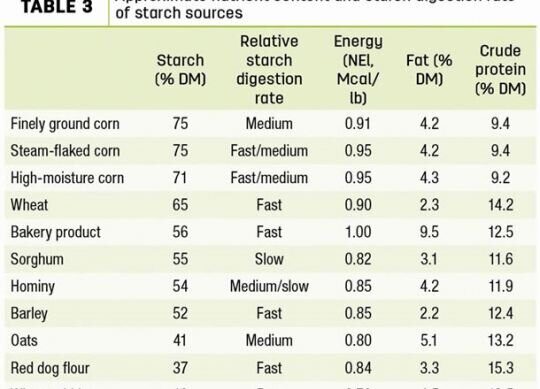Impact of starch digestibility rates on nutrition model predictions
Undigested starch is useless to the dairy cow. Especially when corn prices are high, one goal should be to minimize starch losses in manure. The first step usually taken to reduce starch loss is to evaluate corn grain particle size and most likely, to grind it finer. But, for greater success, more changes may need to be made.
To slow passage rate through the rumen, changes in effective fiber, total mixed ration (TMR) management (to reduce sorting) and cow management (to reduce slug-feeding) may help. To further optimize starch digestion rates, multiple starch sources may be needed and corn silage issues may need to be addressed.
Most of us think of starch as primarily affecting energy available for milk production, reproduction and body condition. However, we need to remember that starch is a primary energy source for rumen bacteria. Since rumen-degradable carbohydrates, non-protein nitrogen and true proteins are converted into bacterial protein, improvements in starch availability often result in an immediate increase in the cow’s amino acid supply, resulting in a quick milk-production response. Complex nutrition models are used by dairy nutritionists to optimize milk production and feed efficiency. In order to predict energy available for rumen bacteria and for the cow, the rate and extent of starch digestion must be accurately predicted for individual diet ingredients. If not, “garbage in” will result in “garbage out.” If starch digestion is under-predicted and too much starch is fed, money will be wasted, and rumen health may be compromised. Over-predicting starch digestion results in less actual milk than you think you will get. As starch digestion increases, predicted milk from energy increases slightly, but predicted milk from protein increases more due to greater rumen microbial protein yield.
Other starch sources
Alternative starch sources should be considered if they are more economical and if they can complement other ration starches to improve productivity. Wheat products and barley grain are degraded at a faster rate than corn starch. Rapidly fermentable starches may boost milk production if they improve the minute-by-minute protein-to-energy balance in the rumen. However, caution should be used with these ingredients, since they can result in more minutes of the day with a pH less than 6. A high extent of starch availability is desired, but a combination of rapidly and slowly available starches will help with acidosis control. Generally, quickly degradable starch sources are included at about 4%-8% of diet dry matter (DM). The table lists commonly available starch sources described in terms of their relative starch digestion rate. Energy is a function of not only an ingredient’s starch content and starch digestibility but also the amount of digestible sugar, fiber, fat and protein.
Adapted from Mary Beth de Ondarza for Progressive Dairy.



